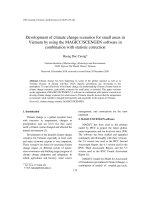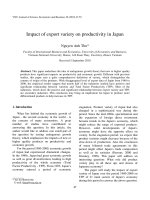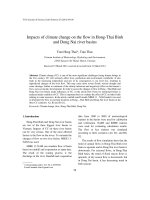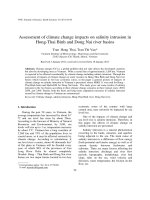Báo cáo " Impact of climate change on water resources in Ca River basin " doc
Bạn đang xem bản rút gọn của tài liệu. Xem và tải ngay bản đầy đủ của tài liệu tại đây (107.97 KB, 8 trang )
VNU Journal of Science, Earth Sciences 26 (2010) 224-231
224
Impact of climate change on water resources in Ca River basin
Hoang Minh Tuyen*
Vietnam Institute of Meteorology, Hydrology and Environment,
23/62 Nguyen Chi Thanh, Hanoi, Vietnam
Received 8 December 2010; received in revised form 22 December 2010
Abstract. Base on Climate Change Scenarios (A2, B2, B1), simulation outputs of river flow show
the changes of water resources in Ca River. These results are arguments for water resources
planning in Ca River under the climate change situations.
Keywords: climate change, water resources, Ca River.
1. Introduction
∗
Climate change (CC) is a major concern of
society in general and Vietnam in particular.
Due to impacts of climate change, water
resources in river is changed in quantity,
quality, regime Within the framework of the
paper, the impact of climate change on flow
characteristics on Ca river basin is reviewed.
Ca river, which is largest river system in
North Central, is the most important source of
surface water for Nghe An and Ha Tinh
provinces. Total area of Ca river basin is about
27.200 km
2
, in which there are 9470 km
2
in the
upper (34%) Laos, 17 730 km
2
(65.2%) in the
middle and lower in most of the territory of two
provinces of Nghe An - Ha Tinh and a part of
the Nhu Xuan district of Thanh Hoa province.
Total annual flow of the river system is about
23.1 km
3
Both of which flows into Laos from
4.45 km
3
and was formed in Vietnam km
3
18.6
(up 80.5%) [1].
_______
∗
Tel.: 84-4-38357106
E-mail:
2. Climate change scenarios in Ca River
basin
Greenhouse gas emissions scenarios which
were selected to develop climate change
scenarios are low emission scenario (B1
scenario), average emission scenario (scenario
B2) and high emission scenarios (scenario A2).
Base period (baseline) is 20 years from 1980-
1999 [2].
2.1. Temperature
In Ca river basin, by the end of the 21
st
century, annual mean temperature would
increase about 1.4
0
C to 2,2
0
C in B1 scenario,
about 2.0
0
C to 3.1
0
C in B2 scenario and about
2.7
0
C to 3.4
0
C in A2 scenarios, relative to the
baseline period (1980 - 1999); After 2050, the
difference in the extent of temperature change
between the scenarios is more evident.
In Ngan Sau River and Ngan Pho river
basins, temperatures rise at the highest rate. In
the period 2080-2099, annual mean temperature
H.M. Tuyen / VNU Journal of Science, Earth Sciences 26 (2010) 224-231
225
would increase to 3.7
0
C at Ha Tinh station,
3.3
0
C at Huong Khe station (table 1, figure 1).
2.2. Rainfall
The change of rainfall in seasons can be
seen throughout the 21
st
century. Rainfall may
increase in the rainy season and decrease in the
dry season at all stations. Rainfall increases
between July and December and decreases in
January and May more than in the other
months. At meteorology stations in mainstream
of Ca River, by the end of the 21
st
century, the
monthly rainfall can increase approximately
12.9% to 29.2 % according to A2 scenario,
24.5% (scenario B2) and 17.4% (scenario B1).
At stations in Ngan Sau, Ngan Pho river basins,
in the rainy season, rainfall increases is less,
only 7% to 9%, while rainfall decreases
significantly by -28% according to scenario A2
in dry season (figure 2).
Table 1. Changes in annual mean temperature (
0
C) relative to period 1980-1999
at some stations in Ca River Basin
Stations
Scenarios Periods
Con
Cuong
Do
Luong
Ha
Tinh
Huong
Khe
Quy
Chau
Quynh
Luu
Tay
Hieu
Tuong
Duong
Vinh
2030 -2039 0.9 0.8 1.0 0.9 0.7 0.7 0.8 0.7 0.8
2040 -2059 1.5 1.3 1.7 1.5 1.2 1.1 1.4 1.2 1.3
2060 -2079 2.3 2.0 2.6 2.3 1.8 1.7 2.1 1.9 2.1
A2
2080 -2100 3.3 2.9 3.7 3.3 2.5 2.4 3.1 2.7 2.9
2030 -2039 0.9 0.8 1.0 0.9 0.7 0.6 0.8 0.7 0.8
2040 -2059 1.6 1.4 1.8 1.5 1.2 1.1 1.4 1.3 1.4
2060 -2079 2.2 1.9 2.5 2.2 1.7 1.6 2.0 1.8 1.9
B2
2080 -2100 2.8 2.4 3.1 2.7 2.1 2.0 2.6 2.2 2.5
2030 -2039 1.0 0.8 1.1 1.0 0.8 0.7 0.9 0.8 0.9
2040 -2059 1.5 1.3 1.7 1.5 1.1 1.1 1.4 1.2 1.3
2060 -2079 1.8 1.6 2.1 1.8 1.4 1.3 1.7 1.5 1.6
B1
2080 -2100 2.0 1.7 2.2 1.9 1.5 1.4 1.8 1.6 1.7
Vinh
0.0
0.5
1.0
1.5
2.0
2.5
3.0
3.5
4.0
2000 2020 2040 2060 2080 2100
Year
∆
t (
o
C)
A2
B2
B1
Figure 1a. Changes in annual mean temperature (
0
C) relative to period 1980-1999 at selected stations.
H.M. Tuyen / VNU Journal of Science, Earth Sciences 26 (2010) 224-231
226
Quỳ Hợp
0.0
0.5
1.0
1.5
2.0
2.5
3.0
3.5
4.0
2000 2020 2040 2060 2080 2100
Year
∆
t (
o
C)
A2
B2
B1
Hương Khê
0.0
0.5
1.0
1.5
2.0
2.5
3.0
3.5
4.0
2000 2020 2040 2060 2080 2100
Year
∆
t (
o
C)
A2
B2
B1
Figure 1b. Changes in annual mean temperature (
0
C) relative to period 1980-1999 at selected stations.
Con Cuông
0.0
1.0
2.0
3.0
4.0
5.0
6.0
7.0
2000 2020 2040 2060 2080 2100
Year
∆
X (%)
A2
B2
B1
Quỳ Châu
0.0
1.0
2.0
3.0
4.0
5.0
6.0
7.0
2000 2020 2040 2060 2080 2100
Year
∆
X (%)
A2
B2
B1
Vinh
0.0
1.0
2.0
3.0
4.0
5.0
6.0
7.0
2000 2020 2040 2060 2080 2100
Year
∆
X (%)
A2
B2
B1
Hương Khê
0.0
1.0
2.0
3.0
4.0
5.0
6.0
7.0
2000 2020 2040 2060 2080 2100
Year
∆
X (%)
A2
B2
B1
Figure 2. Change in rainfall relative to period 1980-1999 (%) at selected stations in Ca River basin.
H.M. Tuyen / VNU Journal of Science, Earth Sciences 26 (2010) 224-231
227
2.3. Potential evapotranspiration (ETo)
Evapotranspiration is an important factor
involved in direct hydrological cycle that causes
changes in flow in the basin. The consequence
of climate change is the change of air
temperature causing change in
evapotranspiration. As the temperature, annual
evapotranspiration will be able to have an
increasing trend. The annual mean potential
evapotranspiration in three climate change
scenarios would increase similarly relative to
baseline scenario. After 2050, the increasing
trend among the scenarios is different; the most
in scenario A2 through B2 to B1. During period
2080-2099, the highest increases is 24.1%
relative to period 1980-1999 in scenario A2,
follow is 20.8% (scenario B2) and 15.2%
(scenario B1) (figure 3).
Vinh
0.0
4.0
8.0
12.0
16.0
20.0
2000 2020 2040 2060 2080 2100
Year
∆Ε
(%)
A2
B2
B1
Hương Khê
0.0
5.0
10.0
15.0
20.0
25.0
2000 2020 2040 2060 2080 2100
Year
∆Ε
(%)
A2
B2
B1
Figure 3. Change in evapotranspiration (%) relative to the period 1980-1999 at selected stations.
3. Impacts of climate change on river flow
In order to assess impacts of climate change
on water resources, the rainfall-runoff model is
used with projected rainfall, potential
evapotranspiration in the future according to
climate change scenarios. Analysing simulation
results from model shows the picture of river
flow in the future.
3.1. Annual flow
Generally, annual flow throughout the basin
tends to increase in all three scenarios.
However, the change in annual in each tributary
has a certain difference.
In period 2030 – 2039: Change in annual
flow between three scenarios A2, B2 and B1
compared to the baseline period is not so much
different. At Yen Thuong on mainstream of Ca
river, annual flow increase by 4.85 to 5.39
(m
3
/s) (about 0.9 ÷ 1.07 %) depending on the
scenarios. At Hoa Duyet stations on Ngan Sau
River, annual flow decreases slightly (table 2).
H.M. Tuyen / VNU Journal of Science, Earth Sciences 26 (2010) 224-231
228
Table 2. Change in rainfall, potential evapotranspiration (ETo) and runoff at selected hydrology stations
in Ca River basin, scenario B2 [3].
Period Station
Rainfall
(%)
ETo (%)
Runoff
(%)
Station
Rainfall
(%)
ETo (%)
Runoff
(%)
1980-1999 0.00 0.00 0.00 0.00 0.00 0.00
2020-2039 2.00 4.56 1.18 1.93 4.78 0.73
2040-2059 3.29 8.20 1.91 3.36 8.77 1.60
2060-2079 4.54 11.62 2.73 4.73 12.49 2.47
2080-2099
Nghia Khanh
5.59 14.04 3.64
Yen Thưuong
5.91 15.15 3.63
1980-1999 0.00 0.00 0.00 0.00 0.00 0.00
2020-2039 2.02 4.62 1.09 0.86 5.56 -0.93
2040-2059 3.46 8.54 1.87 1.53 10.38 -1.57
2060-2079 4.83 12.21 2.81 2.17 14.95 -2.09
2080-2099
Dua
6.01 14.82 3.90
Son Diem
2.71 18.22 -2.26
1980-1999 0.00 0.00 0.00 0.00 0.00 0.00
2020-2039 1.78 5.75 0.43 0.89 5.43 -0.36
2040-2059 3.17 10.45 0.93 1.61 10.32 -0.63
2060-2079 4.50 14.84 1.51 2.29 14.89 -0.86
2080-2099
Thac Muoi
5.62 17.94 2.22
Hoa Duyet
2.87 18.09 -0.91
In period 2080 – 2089, on mainstream of Ca
river, the flow increase quite high relative to
period 1980 - 1999. According to scenario A2,
annual flow at Yen Thuong increases over 5%
relative to baseline. In accordance with
scenarios B2 and B1, annual flow at Yen
Thuong increases from 2.1% to 3.75%. In Ngan
Sau River basin, in period 2080 – 2099, annual
flow is lower the period 1980-1999 and 2020-
2039. At Hoa Duyet station, annual flow
according to scenario A2 reduced 0.98%
relative baseline period. The results
corresponding to B2 and B1 reduced by
approximately 1.06% and 0.96%.
The change of flow in different branches is
the results of the different changes of rainfall
and evapotranspiration according to scenarios
in each sub-catchment. In mainstream, annual
flow tends to increase markedly over the period,
while the tributaries such as La; Ngan Sau tends
to decrease slightly. Flow across the system
tends to increase in accordance with the trend of
rainfall, evapotranspiration and temperature in
different climate change scenarios.
3.2. Flow in flood season
In period 2020 – 2039: In scenario A2,
average flood flow at Yen Thuong station raises
approximately 2.19%; at Hoa Duyet increases
about 0.96% relative to the period 1980 - 1999.
The increasing of average flood flow for
H.M. Tuyen / VNU Journal of Science, Earth Sciences 26 (2010) 224-231
229
scenario B2 at two stations Yen Thuong and
Hoa Duyet are 2.19% and 0.95%, for scenario
B1 will be 2.45% and 1.05%. In this period,
there is no significant difference between 3
scenarios.
In period 2080 – 2099, flood flow increases
considerably over the period and is a big
difference between three scenarios. At Yen
Thuong and Hoa Duyet stations, comparing
with baseline period, according to scenario A2,
flood flow increases about 9.55% and 3.73%.
For scenario B2, results are lower than A2, with
increase by 7.58% at Yen Thuong and 3.01% at
Hoa Duyet. Scenario B1 augments the lowest
rate, only 4.98% and 2.07%.
In general, flow in months of flood season
has an increasing trend. At Yen Thuong station,
flow in August has the highest increasing trend,
from 4.4% in period 2020-2039 to 17.7% in
period 2080-2099 compared with baseline
period in scenario A2. In accordance with
Ngan Sau River where flood season starts later,
from September to December, in period 2020 –
2039, flow in November increases the most
about 1.26% and in period 2080 – 2099, flow in
December has the largest increase is 4.27%.
3.3. Flow in dry season
Normally, flow in dry season has a reducing
trend in entire basin.
In period 2020 – 2039, according to
scenario A2, average flow in dry season at Yen
Thuong would reduce about 2.42% relative to
period 1980 - 1999. At Hoa Duyet station on
Ngan Sau river, average low flow also decrease
3.87% compared with baseline period. The
falling rate of low flow corresponding to
scenario B2 is 2.33% at Yen Thuong station
and 3.79% at Hoa Duyet station, and to
scenario B1 is 2.75% and 3.46%.
In period 2080 – 2099, in scenario A2,
average low flow at Yen Thuong station
reduces 7.16% compared with baseline period.
At Hoa Duyet station on Ngan Sau River, low
flow reduces 12.6%. Corresponding reductions
in B1 and B2 scenarios are 6.9% and 5.75% at
Yen Thuong stations, 11.1% and 8.44% at Hoa
Duyet.
Analyzing flow distribution in dry months
shows that: in the first and middle months of
dry season, although rainfall downs but low
flow still rise because the recharge of ground
water which is cumulated in rainy season. At
the end of dry season, starting transition to
flood season, although rainfall increases a little
but this mount of rainfall almost fills for soil
moisture leading to low flow increases strongly.
Flow in May has the biggest reduction.
According to A2 scenario, average flow of May
in period 2020 – 2039 at Yen Thuong and Hoa
Duyet decrease corresponding 8.8% and 6.8%
relative to period 1980-1999; in period 2080 –
2099, this rare is 26.7% and 26.4%.
Change of annual flow and flow in flood
and dry season at two typical hydrology stations
are shown in figure 4.
H.M. Tuyen / VNU Journal of Science, Earth Sciences 26 (2010) 224-231
230
Figure 4. Rate of change in annual flow, flood flow and low flow (%) at Yen Thuong
and Hoa Duyet stations according to climate change scenarios [3].
Yên Thượng (kịch bản B2)
-12.0
-8.0
-4.0
0.0
4.0
8.0
12.0
1980 - 1999 2020 - 2039 2040 - 2059 2060 - 2079 2080 - 2099
Thời kỳ
(%)
trung bình năm mùa lũ cạn
Yên Thượng (kịch bản A2)
-12.0
-8.0
-4.0
0.0
4.0
8.0
12.0
1980 - 1999 2020 - 2039 2040 - 2059 2060 - 2079 2080 - 2099
Thời kỳ
(%)
trung bình năm mùa lũ cạn
Yên Thượng (kịch bản B1)
-12.0
-8.0
-4.0
0.0
4.0
8.0
12.0
1980 - 1999 2020 - 2039 2040 - 2059 2060 - 2079 2080 - 2099
Thời kỳ
(%)
trung bình năm mùa lũ cạn
Hòa Duyệt (kịch bản A2)
-12.0
-8.0
-4.0
0.0
4.0
8.0
12.0
1980 - 1999 2020 - 2039 2040 - 2059 2060 - 2079 2080 - 2099
Thời kỳ
(%)
trung bình năm mùa lũ cạn
Hòa Duyệt (kịch bản B2)
-12.0
-8.0
-4.0
0.0
4.0
8.0
12.0
1980 - 1999 2020 - 2039 2040 - 2059 2060 - 2079 2080 - 2099
Thời kỳ
(%)
trung bình năm mùa lũ cạn
Hòa Duyệt (kịch bản B1)
-12.0
-8.0
-4.0
0.0
4.0
8.0
12.0
1980 - 1999 2020 - 2039 2040 - 2059 2060 - 2079 2080 - 2099
Thời kỳ
(%)
trung bình năm mùa lũ cạn
Yen Thuong (Scenario B1
)
Yen
Thuong (Scenario B2)
Yen
Thuong (Scenario A2)
Hoa Duyet
(Scenario B1
)
Hoa Duyet
(Scenario B
2)
Hoa Duyet (Scenario A2)
Period
Period
Period
Period
Period
Period
H.M. Tuyen / VNU Journal of Science, Earth Sciences 26 (2010) 224-231
231
4. Conclusions
Climate change scenarios for Ca River
basin in 21
st
century are developed
corresponding to low, medium and high
emission scenarios. Base on climate change
scenarios, the changes in water resources has
assessed.
At the end 21
st
century, overall Ca basin,
annual mean temperature increases about 2.2
0
C
relative the period 1980 -1999 and would be
reach to 3.7
0
C in Ngan Pho, Ngan Sau River
Basin. Average potential evapotranspiration
(ETo) in Ca basin rises from 13% to 24%.
Total annual rainfall in Ca basin by the end
of 21st century tends to increases from 3% to
6% compared with period 1980 - 1999. In rainy
season, rainfall may increase over 9%,
maximum increasing in a month can be reach
nearly 30%. In dry season, rainfall decreases
from 2% to 9%, and largest reduction rate in a
month can be found about 27% at several
locations.
Climate change could lead into increasing
annual flow volume. In mainstream, by the end
of 21st century, average annual flow increases
about 3%. In Ngan Sau, Ngan Pho rivers, it
reduces about 0.9% relative to period 1980-1999.
In flood season, average flood flow
increases about 10% in mainstream of Ca river
and 3.5% in Ngan Pho, Ngan Sau rivers.
Average monthly flow in flood season could
increase 16% in mainstream and 3% to 4% in
tributary relative to baseline period.
Average low flow on overall basin has a
decreasing trend, with greater reducing on right
side of Ca basin. Average flow in last month of
dry season and transition month to flood season
reduces the most.
Acknowledgements
The author acknowledges the financial
support by Danish International Development
Agency (DANIDA) for the project "Impacts of
climate change on water resources and
adaptation measures".
References
[1] Tran Thanh Xuan, Hydrological features and
river water in Vietnam, Hanoi, 2007 (In
Vietnamese).
[2] Ministry of Natural Resources and Environment,
Climate change, sea level rise scenarios for Viet
Nam, Hanoi, 2009.
[3] Vietnam Institute of Meteorology, Hydrology
and Environment, DANIDA project report
"Impact of climate change on water resources
and adaptation measures", Hanoi, 2010.









